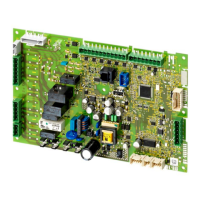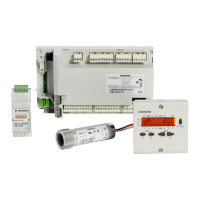368/617
Building Technologies Division User Manual LMS14… CC1U7471en
6 The settings in detail 28.01.2015
Keep hot function
The Keep hot function is also activated and deactivated by the DHW inlet temperature
acquired by sensor B39, provided no operating mode of higher priority is active.
The setpoint for the sensor B39 is determined by the adjusted Setpoint keep hot (5460).
If this parameter is set to OSV, the current setpoint for DHW consumption is used as
the Keep hot setpoint.
If, on completion of DHW consumption, a change to Comfort mode Keep hot is made, a
timer is started, running for the period of time ParTimeMinWarmhaltungEin. The Keep
hot function remains active as long as the timer runs. This ensures that the Comfort
function is active for a minimum period of time.
The reason for the minimum on time is to make certain that – at the end of DHW
consumption – the plate heat exchanger is maintained at the Keep hot setpoint for a
certain period of time, in case DHW consumption is interrupted for a moment (when
taking a shower: water consumption - end of consumption - soaping - water
consumption; when opening the tap the second time, cold water is not wanted; the
boiler water may cool down the DHW storage tank, the reason being the low setpoint of
the heating circuit). To force the burner to shut down on completion of DHW
consumption when changing to Comfort mode (preventing scalding if consumption is
interrupted for a moment), a timer can be parameterized, running for the period of time
ParTimeBurnerOffAquaBoost. When changing from DHW heating to the Keep hot
function, the burner remains Off for the parameterized period of time.
Detection of DHW consumption via sensor B39
To keep the plate heat exchanger at a certain temperature level, the Keep hot function
is used. It maintains the DHW inlet temperature at a high level, thus ensuring a
sufficiently high temperature differential (falling ∆T/∆t gradient) to trigger DHW mode.
To detect the end of DHW consumption, the gradient must be rising (slope must be
sufficiently steep).
On completion of DHW consumption, a change to the Keep hot function can be made,
thus enabling the DHW inlet temperature acquired by sensor B39 to return to a higher
level. This takes place when the above described switch-on condition for the Keep hot
function is satisfied.
The burner is started up by the 2-position controller. When DHW consumption is
detected via a sufficiently steep negative temperature gradient of the DHW inlet
temperature, the 2-position controller puts the burner into operation. If the temperature
acquired by sensor B38 (DhwOut) lies below the DHW setpoint, the switch-on condition
for the burner is satisfied. If the actual value were above the setpoint plus the switch-off
threshold, the burner would not be put into operation by the 2-position controller.
Deactivating the DHW mode via comparison of the absolute temperature values
(aqua booster)
In addition to the positive gradient which – if the slope suffices – ends the DHW mode,
a second criterion can be activated, ending the DHW mode. Here, the 2 absolute
temperature values of sensor B38 (DHWOut) and sensor B39 (DHWIn) are compared.
If the differential is smaller than threshold AbsTSwitchOffTresh [4772.1], the DHW
mode is ended. If the 2 temperatures approach one another, it can be assumed that
there is no DHW consumption. Comparison of the absolute temperatures can be
activated or deactivated via AbsSwitchOffCondAqBo [4766.1].

